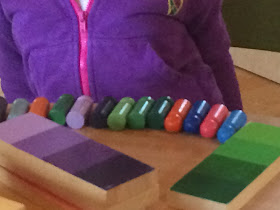In the aftermath of Ophelia storm, as the children came back to preschool, there was a lot to talk about and to share. The children wanted to talk about what they had seen or heard and many said they were scared because the wind was "noisy" and because the electricity went off, leaving them in the dark.
So I went to the storage room and dug up a book I don't use very often called "Feel the wind" by Athur Dorros.
So I went to the storage room and dug up a book I don't use very often called "Feel the wind" by Athur Dorros.
Now, the book can be a bit technical at times. So I skipped certain pages, changed the wording and made it as simple and interesting as possible for my 3 to 5 year olds. Then I ask the children a few questions at circle time: What can the wind do? How can you see when it is a windy day? Answers:
Wind moves the clouds in the sky
Wind can make your clothes dry quick outside on the washing line
Wind can make your clothes dry quick outside on the washing line
Wind makes the wind turbines turn and turn
Wind make our kytes fly high in the sky
Wind make things and people move
Wind can move small things
Wind cannot move rocks and heavy things
To illustrate the last 2 statements, I gathered several items around my home: pebbles, feathers, a sheet of paper, a marble, a miniature bale of hay, buttons, pom-poms, wooden blocks and a ball. I brought my hairdryer and plugged it in. I explained the children that my hairdryer was like the wind: "if I blow my hairdryer on this marble, do you think the wind will be strong enough to move it?" They had to give me predictions first and when they saw what happened, we placed the objects into 2 categories: heavy and light. To tell you the truth, this was such a great experiment!! Every time an object moved, the children giggled and laughed and clapped hands!! It was absolutely brilliant!! Here are a few photographs of our little experiment:
Next, we talked about the fact that it is a good thing the wind makes the turbines turn as it helps producing electrivity. And I asked them :
"what works with electricity in your house?"
I should probably have recorded how many times "my wii", "my brother's X-Box", "my sister's Playstation" were mentioned!!!!! Children are moving on with the technology. It was exciting to make them realise that practically everything they need and like works with electricity!!!! And Ophelia was the best experience as they had loads to say about it.
I also asked the kids to tell me how they could see it was a windy day outside. "The trees are moving, the leaves too. And the flowers!! ". Then, we went outside and I asked them to close their eyes. I asked again how they could now tell it was windy. "My hair is blowing!!" and " I can feel it on my cheek". Another child cleverly said "I can hear it!" and another one added "..and I can hear the wind chimes making music too!".























